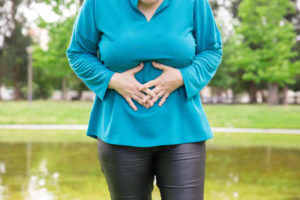 Postmenopausal women may be at risk for nonalcoholic fatty liver disease (NAFLD), a chronic condition caused by the build-up of excess fat in the liver not caused by alcohol. A review article by the Translational Genomics Research Institute (TGen) has suggested that these findings offer a new perspective on health risks for postmenopausal women.
Postmenopausal women may be at risk for nonalcoholic fatty liver disease (NAFLD), a chronic condition caused by the build-up of excess fat in the liver not caused by alcohol. A review article by the Translational Genomics Research Institute (TGen) has suggested that these findings offer a new perspective on health risks for postmenopausal women.
Nonalcoholic fatty liver disease is the most common cause of liver damage which can lead to liver cirrhosis and death. It affects nearly 1 in 4 people worldwide and is often associated with obesity, abnormally high amounts of lipids in the blood, and type 2 diabetes. It is also one of the leading indicators for liver transplants.
Advertisement
The review included an analysis of more than 60 epidemiological, clinical, and experimental studies. It suggests that the risk of NAFLD is greater among postmenopausal women compared to premenopausal women. The level of an endocrine hormone called estradiol, or E2, which is produced by the ovaries, declines significantly following menopause. This is the hormone involved in the regulation of the estrous and menstrual female reproductive cycles.
Menopause, also known as the climacteric, is the time in most women’s lives when menstrual periods stop permanently, and they are no longer able to bear children. Menopause typically occurs between 49 and 52 years of age.
NASH
Nonalcoholic fatty liver disease (NAFLD) can progress to a more dangerous condition called nonalcoholic steatohepatitis (NASH). When this condition occurs, it indicates there is both inflammation and liver cell damage, along with fat in the liver. Among women, NASH is now the leading indication for liver transplantation. A liver transplant is the most effective treatment strategy against NASH, however NAFLD recurrence in transplant patients is high.
“The mortality rate is rising among women with NAFLD, and more are dying from cirrhosis, suggesting that many women have NASH, rather than just NAFLD,” says Dr. Johanna DiStefano, a Professor and head of TGen’s Diabetes and Fibrotic Disease Unit, and the study’s senior author.
Advertisement
The review did find that normal-weight women with glucose, lipid, and insulin levels within normal ranges were at a low risk for developing NAFLD. This could mean that women who are healthier overall while going through menopause have a lower chance of risks associated with the aging process.
“Efforts to emphasize healthy diet and regular physical activity should be urged in middle-aged women as they approach menopause to prevent the development of NAFLD,” Dr. DiStefano said.
The number of cases of nonalcoholic fatty liver disease in the U.S. is expected to grow to more than 100 million withing the next decade. This review helps to outline a possible way for women going through menopause to reduce the risk of NAFLD by adopting a healthy lifestyle.
